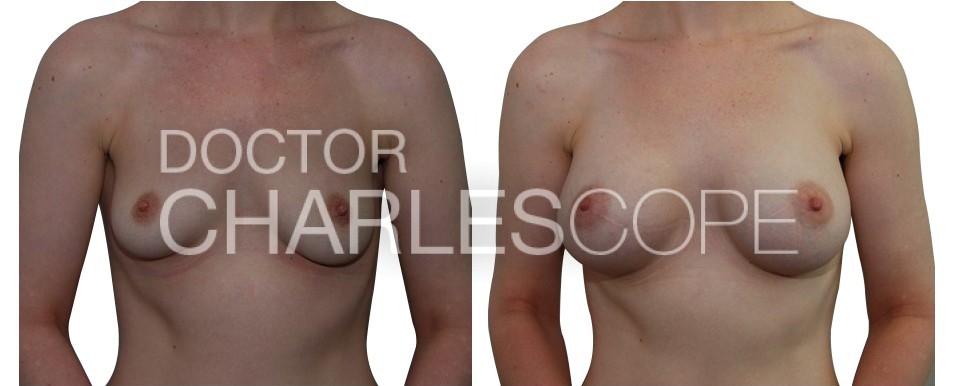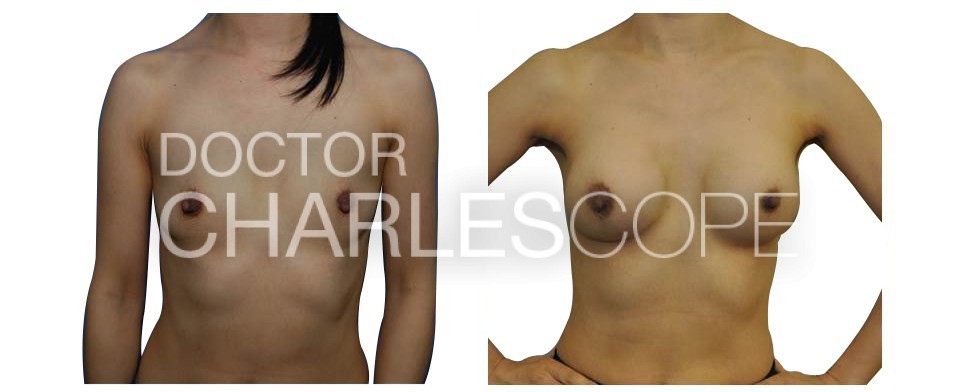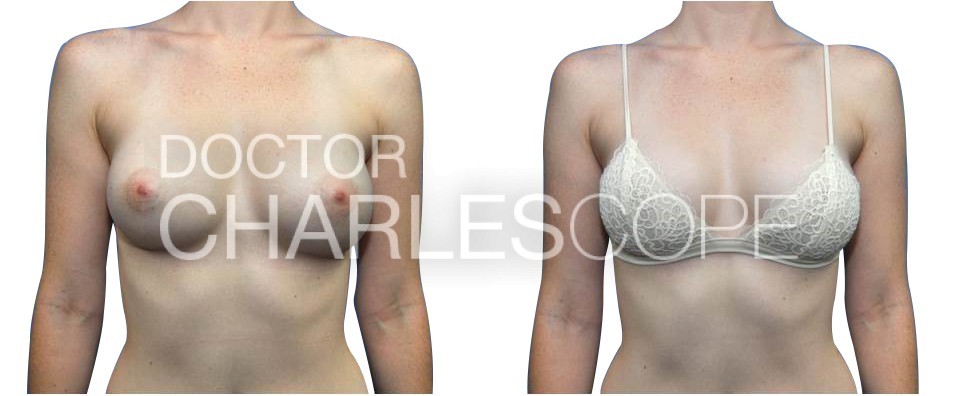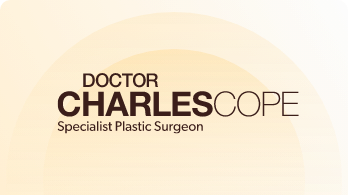Surgery for breast enlargement, known as breast augmentation mammoplasty, is designed to enlarge the breasts using breast implants. Surgeons can also use breast implants to correct a small amount of breast ptosis or loose skin which can occur after pregnancy and breastfeeding. If there is a large amount of loose skin, then we can combine the procedure with a breast lift (also known as Mastopexy surgery). There are many choices and options, which require careful planning to work out which is a good option for you. All of these choices have pros and cons, which you should understand before you make the decision.
Seven out of eight women have minor differences between their breasts, which is normal. Minor differences in the size and shape of your breasts will not change. The difference may even be more obvious after breast augmentation mammoplasty surgery.
We can address minor volume differences with fat transfer to the breast. Otherwise, if there is a large volume difference between your breasts, different-sized breast implants can help to address asymmetry if this is bothering you. If you are interested in getting this procedure or want to know more, you may book a consultation with qualified mammoplasty breast augmentation surgeon Dr Cope in Sydney.
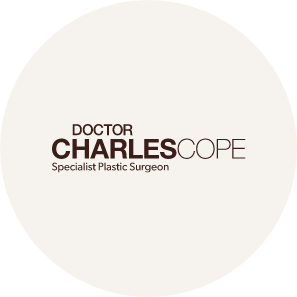
choices and options for Breast augmentation mammoplasty with implants
There are two options for the placement of breast implants: they are placed either behind the breast tissue or under the muscle on the chest wall (pectoralis muscle). Breast implants placed underneath the muscle have a more sloping shape, a lower chance of capsular contracture (hardening), and it is easier for mammography. However, if you do a lot of upper limb gym work, then implants can be placed under the breast. The surgeon can insert breast implants in three ways: through an incision under the areola, in the crease under the breast or via the armpit.
Most patients choose silicone breast implants rather than saline breast implants, which can cause rippling through the skin. Modern silicone implants are substantially different from the old type of silicone implants in the 1970s and 80s. The casing of the implant is much thicker and usually has a textured surface, which reduces the chance of hardening of the implant. Cohesive silicone gel implants contain a gel that is similar in consistency to a set jelly, which retains its shape and does not run like a liquid, as the old silicone gel did. Another advantage of cohesive gel implants is that they can be breast-shaped, helping to blend with the natural shape of the breast. Your choice of breast implants will largely depend on your desired results, which you’ll discuss with Dr Cope.
Breast augmentation mammoplasty surgery requires a general anaesthetic and takes about one hour. It is usually performed as a day-stay or overnight procedure. Following the surgery, it is important to restrict yourself to light activities, with no lifting or heavy duties, for 7-10 days. Most patients may drive again and return to work within 10 days after the surgery*. You should not do heavy exercise or sport for at least one month following breast surgery*.
*Note results vary from patient to patient
A good candidate for breast augmentation mammoplasty surgery
Commonly known as a breast job, breast augmentation mammoplasty creates a larger breast size. If you have loose skin or mildly ptotic breasts, which commonly often occur after pregnancy, breastfeeding and weight loss, breast implants can target these problems. Breast implants are also one of the options to target volume differences between your breasts if you have a large size difference and this is bothering you.
Suitable patients should be in good health and have realistic goals. If you have any underlying conditions, you should ensure to bring these up with Dr Cope during your first consultation. If you are healthy, have fully developed breasts, and want a larger breast size, you might be a candidate. To find out for sure if you qualify for the procedure, book an appointment with Dr Cope and his friendly team.
Your consultations with Dr Cope
Patients will need to have two pre-op consultations with Dr. Cope. The first will take around 30 to 45 minutes, and it’s where you’ll gain an idea of what the surgery can do and whether you’re a candidate. We normally schedule the second consult up to two weeks later to discuss your desired procedure further.
The consulting process benefits both you and your surgeon, as it helps clarify your goals, needs, and options. You can use these appointments to ask further questions about what you can achieve from surgery and address any concerns you have. Dr. Cope will discuss your options and explain what’s required before, during, and after surgery. He will also outline the risks and side effects so that you’re fully aware and informed.
Your consultation is also where you’ll outline to your surgeon your reasons for wanting the procedure. This means you should go in with an idea of your desired results, and then discuss if they are realistic and achievable. Book your appointment to learn more about this procedure and whether it can help you achieve your desired outcome.
Breast augmentation mammoplasty surgery cost
Several factors can affect the total costs of your breast augmentation mammoplasty surgery. We can outline your total cost once we have an idea of your surgical plan. Your cost will be affected by things such as:
Surgeon’s fees
This usually includes the cost of postoperative care. Your surgeon’s fees will depend on their qualifications and experience.
Anaesthetist’s fees
This will also depend on the experience of the anaesthetist. Depending on the anaesthetist, they may charge by the hour or procedure.
Initial consultation fees
You’ll need to pay $380 when you first consult with your surgeon regarding the procedure.
Cost of breast implants
This will depend on the type of implant that will suit your body type and desired results. The cost of breast implants also depends on the brand. Typical costs vary between $1700 and $2500 for both breast implants.
Hospital fees
You may need to pay more if you need to stay overnight (usually about $350 to $400 extra). Depending on your condition, you may be able to go home the day of your surgery.
Other costs
This includes medical tests, supportive garments, and other materials used during your surgery.
During your consultation with Dr Cope, we will discuss all of the factors that may affect the total costs of your surgery. The total price of a breast augmentation mammoplasty (including surgeon, anaesthetist, implants, and hospital fees) starts at around $10,500 but can go up to $12,500 or more, depending on the type of implant used and the complexity of your procedure. After the consultation, we will provide you with an accurate estimate of the costs involved.
Medicare rebates
Medicare rebates are available only for people whose surgery is performed for a medical reason, and who meet certain criteria. Most patients get breast augmentation surgery (mammoplasty) for cosmetic reasons. Therefore, you’ll likely not be eligible for any such rebates with this surgery alone.
Breast augmentation The procedure
The next step after your consultations is the procedure. Breast augmentation mammoplasty is performed with general anaesthesia. This is to prioritise your comfort, and it means you will be asleep during your surgery. During the actual surgery, the techniques vary according to the patient’s surgical plan. Dr Cope will make incisions through which to insert your breast implants. There are several places where the surgeon may make the incisions, such as:
- The crease beneath the breast (inframammary)
- Around the nipple (periareolar)
- Under the arm (axillary)
Once Dr Cope has made the incision, he will then create a pocket in the breast to make way for the implant. He inserts the implant and closes the incision with care. You will then be monitored until you are well enough to go home. We may prescribe pain medication to help you through the initial recovery.
Breast Augumentation Recovery & aftercare
The recovery process is important after surgery. You will need to take time off work and ensure that you adhere to Dr Cope’s recovery instructions. Everyone’s recovery process looks slightly different. However, there are some general things you can expect, such as some degree of pain and discomfort. You can also expect to follow aftercare guidelines such as:
- Wear a support garment to help reduce swelling
- Reduce your physical movement
- Take time away from work and driving
- Sleep on your back with your upper body propped up
- Drink enough water and eat a healthy diet
- Resume light physical movement gradually
- Avoid smoking and alcohol, as these can increase risks
- Report any concerning symptoms to Dr Cope
During recovery, it’s also important to have enough support around the house. This is especially the case if you have young children. It’s best to make the required arrangements before surgery to facilitate the healing process. Ensure that you wear your support garment and avoid putting pressure on your healing breasts. You should gradually be able to resume your normal routines. However, make sure that you refrain from exercise for at least four weeks or until Dr Cope advises.
Breast augmentationRisks and complications
Knowing about risks is important in the planning phase of any surgery. Like all surgeries, breast procedures come with risks that you should be aware of in order to be prepared and well-informed. Although choosing a good surgeon reduces your risk, there is no way to eliminate risks completely. You should speak about risks with your surgeon and make sure that you are clear on what can go wrong.
Every patient will have some degree of swelling, bruising, and discomfort after surgery. This is normal. However, if these symptoms are severe or prolonged, you should seek help. Other risks can include:
- Poor scarring
- Infection
- Excessive bleeding
- Prolonged pain
- Anaesthesia reactions
- Capsular contracture
- Implant rotation
- Implant rupture or leak
- Inability to breastfeed
- Seroma
- Nerve damage
If you see any worrisome signs after surgery, you should seek medical attention or contact your surgeon.
How to manage scarring
Patients should be prepared to have some scarring, as this is a normal result of surgery. The scars will not completely disappear, but with the proper care, they should fade somewhat.
If you are worried about scarring, you should bring this up with Dr Cope. He can help you understand what to expect in terms of scarring, and provide some methods to care for your incisions. For example, you might benefit from using tape such as Micropore tape or silicone tape on the scars for the first 3 months or so. Some people may be more prone to scarring than others, and this is important to keep in mind.
Frequently Asked Questions
Breast augmentation mammoplasty can be performed at any age once your breasts have stopped developing (often about 16-18 years of age). If you are planning to have children in the future, then you should wait until after pregnancy and breastfeeding. This is because pregnancy changes your breasts, and as a result, can compromise the result of breast augmentation mammoplasty. However, if you are young and this is many years away, then this may not be an issue. Many patients also have breast augmentation mammoplasty after having children to correct changes that have occurred with pregnancy and breastfeeding.
There is a risk that breast augmentation mammoplasty will affect your ability to breastfeed. However, this is uncommon. It is important to realise that only about two-thirds of mothers can successfully breastfeed even if they have not had breast surgery.
A breast augmentation mammoplasty is not permanent, but usually lasts 10-15 years*. How long it lasts depends on the size of your breasts (larger breasts drop faster if they are not well supported), weight changes, and hormonal changes. Even if your weight is stable, hormonal changes such as pregnancy, breastfeeding & menopause can cause your breasts to change. Also, as time goes on, the chance of something happening to the breast implants also increases*. Therefore, at some point in the future, you may require breast revision surgery. This is something you should think about before getting your first breast operation.
The surgeon usually places the incision in the crease underneath the breast. This method is often the surgeon’s choice, as it helps achieve good implant placement.
Most breast implants are placed underneath the pectoralis major muscle, which helps achieve the desired implant shape. This placement also lowers the chance of long-term problems such as capsular contracture and rippling and is easier for mammography.
Breast implants are available as round or shaped implants – which one is right for you depends on many factors, such as the result you are trying to achieve. It also depends on your body shape, how much breast tissue you have naturally, what shape your breast is and what size implant you want. If you have a reasonable amount of breast tissue before the surgery or want more upper pole fullness, then a round implant may be a better choice. Dr Charles Cope will discuss these options with you.
Modern cohesive silicone implants tend to have lower risks than smooth implants that were used in the 70s and 80s. The commonest cohesive silicone implants used in Australia are produced by Mentor (owned by Johnson & Johnson). They have been in use for 30 years and have a long track record. Some patients choose modern versions of the smooth silicone implants (e.g. those made by Motiva) because of the lower risk of BIA-ALCL (breast implant-associated anaplastic large cell lymphoma). BIA-ALCL is more common with textured breast implants. Dr Charles Cope will discuss these options with you.
Usually the incision is placed in the crease underneath the breast, which gives allows the surgeon to give the best placement of the implant, modification of breast tissue if needed and the best cosmetic result.
Most breast implants placed underneath the pectoralis major muscle, as this gives a more natural shape, a lower chance of long-term problems such as capsular contracture and rippling, and it is easier for mammography.
Breast implants are available as round or shaped implants – which one is right for you depends on many factors such as the result you are trying to achieve, how thin you are, how much breast tissue you have naturally, what shape your breast is and what size implant you want. If you are thin and want a natural result, so that no one knows you have breast implants, a shaped implant may be the best choice. If you have a reasonable amount of breast tissue before the surgery or want more upper pole fullness, then a round implant may be a better choice. Dr Charles Cope will discuss these options with you.
Modern cohesive silicone implants have had a textured surface for 30 years, with far fewer problems than the old type of smooth implants that were used in the 70s and 80s. The commonest cohesive silicone implants used in Australia are produced by Mentor (owned by Johnson & Johnson), and have been in use for 30 years and have a long track record. There are newer modern versions of the smooth silicone implants (e.g. those made by Motiva), which some patients are choosing because of the rare risk of BIA-ALCL (breast implant associated anaplastic large cell lymphoma), which is associated with textured breast implants. Dr Charles Cope will discuss these options with you.
Modern breast implants have been widely used for 30 years. However, there are always risks involved, and in mammoplasty breast augmentation, old implants will need replacing. Possible problems include capsular contracture, implant displacement or movement, and rupture. On average, implants last 10-15 years, with 2-3% of people needing another operation every year. In some cases, implants can last longer than ten years without problems*.
There have been increasing reports of a rare form of cancer associated with textured breast implants – BIA-ALCL. This is rare (estimates run at about 1:36,000).
As time goes on, the chance of having problems with your breast implants increases. So, you will probably need to have revision surgery at some point. Implants don’t last forever, and with time, there are increased risks of capsular contracture, implant displacement or movement, and rupture. On average, implants last 10-15 years*, with 2-3% of people needing another operation every year. The results aren’t the same for everyone, and it’s important to keep your goals realistic.
Recently, an increasing number of patients have had small-volume breast augmentation mammoplasty performed using fat transfer alone. However, it can be more difficult to create a larger breast size with only one fat transfer procedure (much less than the average increase in size from breast augmentation mammoplasty). Therefore, a person might require multiple fat transfer procedures (sometimes even 3 or 4) to achieve the result they could attain with one breast augmentation mammoplasty*.
Many people have other procedures performed at the same time as breast augmentation mammoplasty. The most common of these are liposuction, upper eyelid surgery (blepharoplasty), and labiaplasty.
The operation is a day-surgery or overnight stay procedure in an accredited hospital, depending on what you are like with anaesthetic recovery.
It is normal for scars to be red, lumpy, and obvious for 6-8 weeks after surgery. After this, they should start to fade gradually. Most patient scars fade to pale by one year, although sometimes this process can take two or more years. The simplest way to help this process is to keep tape such as Micropore tape or silicone tape on the scars for the first 3 months or so. An alternative to this is to massage the scars.
During the first week after surgery, you need to rest and take things slowly at home. When you go home, there will be waterproof dressings covering your breasts, which normally stay on for one week, allowing you to shower normally. Most people find these dressings supportive, but if you find it more comfortable to wear a supportive sports bra, that’s fine. Some people feel well enough to drive to the postoperative visit, which is usually 5-7 days later. Most people return to office work within 10 days after breast augmentation mammoplasty*.
When will I feel completely normal and be able to play sports after breast augmentation mammoplasty?
For most people it is at least 4 weeks until they are ready to return to sport and full activities*.
*Note results vary from patient to patient


